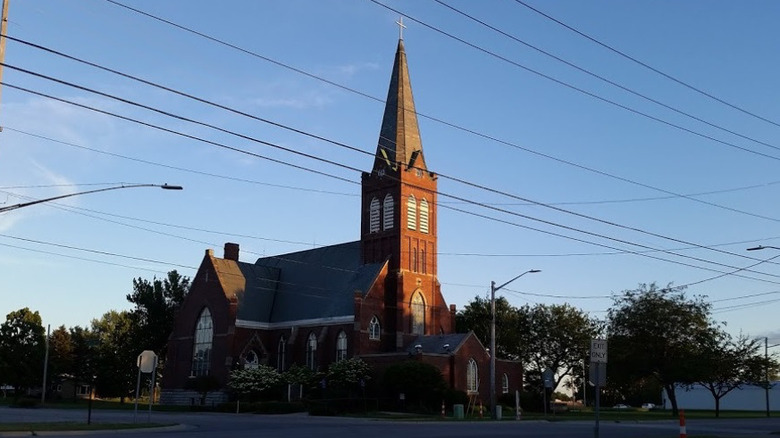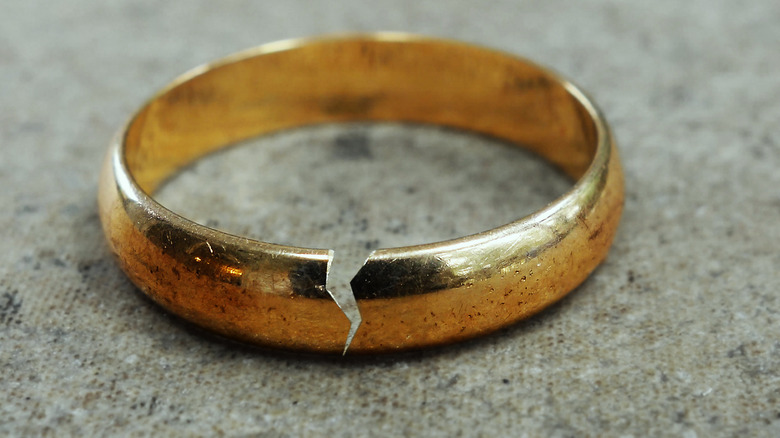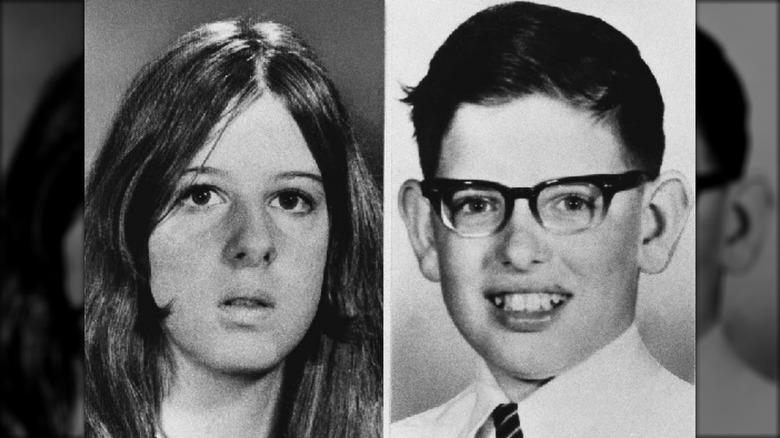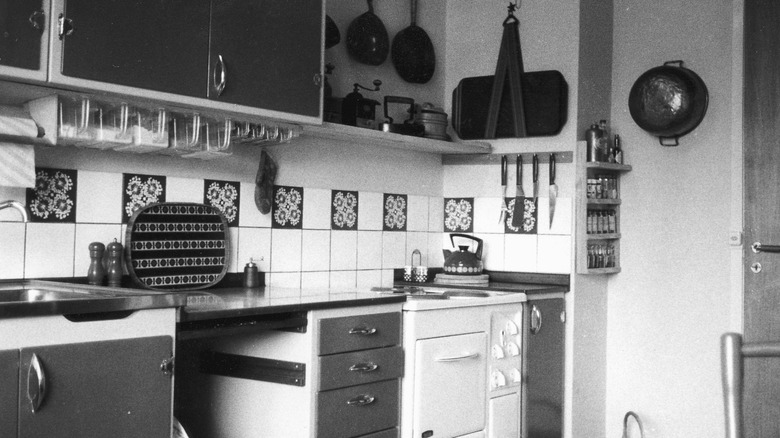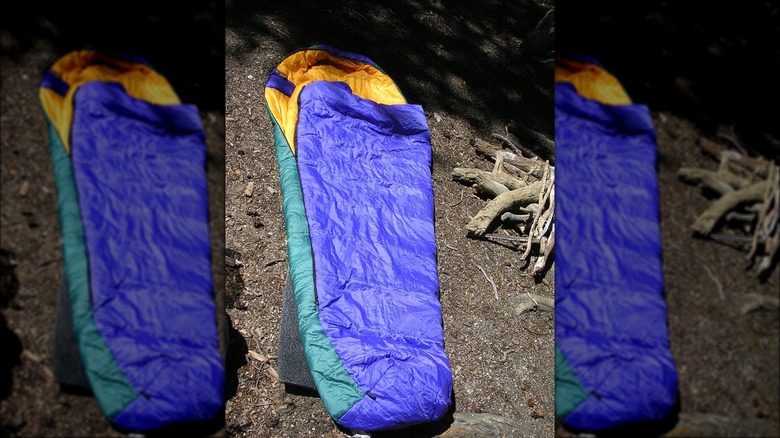The Terrifying True Story Of The List Family Murders
The scene inside the mansion was difficult to forget. As investigators recalled to NJ.com, it was cold inside Breeze Knoll, the expansive home in the affluent town of Westfield, New Jersey. That would have been odd enough, given that six members of the List family lived there and it was December. But neighbors had noticed lights inside the mansion going out one by one over the course of November and December of 1971. Soon, the police were called.
Entering the home, police found the bodies of grandmother Alma List, mother Helen, and the three children: 16-year-old Patricia (called Patty by the family), 15-year-old John Jr., and 13-year-old Frederick. Helen and the children were laid out on bloodstained sleeping bags in the home's ballroom. Alma was upstairs near her third-floor apartment. All three had been shot.
But the father, John List, was missing. The discovery of a series of letters written by him made it clear he was the killer. But why had he done it? And where had he gone? The truth was far darker than investigators and shocked neighbors suspected. This is the terrifying true story of the List family murders.
John List had a tense relationship with his parents
John List was born on September 17, 1925, in Bay City, Michigan. According to "Death Sentence: The Inside Story of the John List Murders," both his parents were descended from German immigrants, many of whom were evangelical Lutherans. His parents, John Frederick and Alma, were highly religious and moralistic. As a result, young John was forced to live a constricted existence. John Frederick was, by all accounts, largely uninterested in his son. Instead, the actual work of raising "the boy," as his father referred to him, fell to Alma, who doted on him to a smothering extent.
Per "Death Sentence," not only was the younger John expected to be a regular church attendee, but he was often barred from getting messy, doing anything even vaguely dangerous (like going outside without multiple layers of clothing), or interacting with children Alma deemed unworthy. He was expected to meticulously clean up after himself and to fulfill the role of dutiful, untroublesome son.
It is almost certainly here, under the overbearing tutelage of his mother, that John List came to see the world as a threatening place. He would only be able to stand up against the chaos through constant vigilance and with an unyielding sense of morality and structure.
List had a fraught marriage
John List enlisted in the U.S. Army in 1943, where, per MLive, he went on to earn a master's degree in accounting. He also served in Europe during World War II, even becoming a prisoner of war for a few hours.
While stationed in Virginia in 1951, John met Helen Taylor. According to NJ.com, Helen was a young widow and mother. She was physically scarred from a medical accident, when a doctor spilled caustic ether into her eye during the birth of her first daughter (via "Death Sentence"). Only a month after their meeting, Helen informed John that she was pregnant. They agreed to marry, but then it became clear that Helen had either been mistaken, had a miscarriage, or even lied to John.
What is certain is that Helen had syphilis, via her first husband. She wasn't contagious when she married John, but the disease would eventually destroy her brain. Her issues with alcohol didn't help, either. Still, the pair doggedly stayed together and had three children: Patricia, John Jr., and Frederick.
He was barely noticed
If John List was known for anything in his adult life, it was for being completely unremarkable. He was an uptight conservative who worked a series of dull accounting jobs that weren't exactly the stuff of rip-roaring tales or even amusing anecdotes.
John List seemed to put real effort into making sure his family stood apart from the people around them. According to MLive, when the List family first moved into the Westfield, New Jersey mansion known as Breeze Knoll, neighbor Harry Devlin went over to say hello, bringing along a pie. When confronted by the offer of friendship, John curtly told Devlin, "We don't socialize." He still took the pie.
On the rare occasion someone noticed John List, he struck many as odd. According to NJ.com, a few people recalled him mowing the mansion's lawn on a hot summer day — in a suit and tie. He also dressed up to collect his daughter, Patty, from the local police station in the middle of the night. She'd been picked up for the benign offense of wandering around town with her friend, but John's fury lingered in witnesses' memories (via "Death Sentence"). He also had tone-deaf aspirations, as when he told neighbor Dr. Bill Cunnick that he wanted to sell insurance. Cunnick, who knew John List to be the textbook embodiment of "antisocial," was floored (via NJ.com).
John List was a professional failure
Though he had a graduate degree in accounting, per MLive, the business world demanded a more personable touch. And people rarely put "personable" and "John List" together in the same sentence.
Things didn't always seem so bad. When the Lists moved to Westfield in 1965, John was a vice president at a bank, per ABC News. Then he lost that job — and the next one, and the next. He started telling his family he was off to work, but then took the train a few stations up and spent the day reading newspapers, stewing over his predicament.
Moreover, it was Alma List who had ponied up the cash for the down payment on the List house, given that John and Helen had never quite lived within their means. According to "Death Sentence," Alma's help came with a catch: she was going to move in. Helen, who had never gotten along with her mother-in-law, was reluctant but agreed if it meant they were to occupy a mansion. Alma thus moved into an apartment on the third floor of the List family home, in a move that she would later admit made her deeply unhappy.
His family was kept under strict rules
Growing up in the List family was hardly the stuff of idyllic childhood memories. Brenda, Helen's daughter from her first marriage, had some fond recollections of her stepfather, per "Death Sentence." Yet she was rejected once she became pregnant at 16. According to NJ.com, Brenda was sent off to a home for unwed mothers, a cruel act that may have saved her life.
As for the other children, any step outside their father's rules was cause for punishment. In the summer of 1971, when Patty was held at the local police station after officers caught her and a friend wandering the town at night, John List's reaction spoke volumes. According to "Death Sentence," he saw his daughter's presence in the police station as both a symptom of her growing rebellion and a portent of where her actions would take her. Sixteen-year-old Patty was talking about being an actor, for one. She also once wore a shirt that proclaimed "Make Love, Not War," such an offensive statement that John ripped the shirt off his daughter while screaming at her. "She believed her father truly hated her," recalled a friend of Patty's (via "Death Sentence").
List's children suspected he would kill them
Far from being oblivious, the List children may have known what was coming. According to "Righteous Carnage: The List Murders in Westfield," Patty told her drama coach, Ed Illiano, that her father had threatened to kill the whole family after a particularly bad argument. In fact, she revealed this frightening anecdote to Illiano mere days before her death.
But John List had been making these sorts of threats for a while. According to NJ.com, Patty told a friend that her father had been chillingly direct with them, asking the children if they wanted to be buried or cremated. List himself later recalled this exchange during an interview with ABC News. "I thought I was being real clever," he said.
The weekend before John made good on his promise, Illiano had actually visited the family at Breeze Knoll (via "Righteous Carnage"). There, John Jr. had grabbed Illiano's arm and said that he really should come over more often. Things got even stranger from the drama coach's perspective when, on Monday, Patty had called and asked him to visit again. He couldn't, but later recalled that something about the home and the family had turned sour.
Multiple factors pushed List to murder
John List was supposed to be a financially successful paterfamilias, yet he was a professional dud. His wife and children rarely lived up to his expectations. Then there was the mansion. Helen had pushed hard for John to buy Breeze Knoll. Yet, as "Death Sentence" notes, the stately home was hard on the List finances. As time went on, it became clear that the aging building was a money pit, with costly repairs looming over an already burdensome mortgage. According to "Righteous Carnage," at the time of the murders, John had only $200 in cash and a horde of bills due.
He was also worried about his children's souls. As he told ABC News in 2002, John List concluded that any financial downsizing would split up the family and lead the children further away from their strict Lutheran lifestyle. Helen had even threatened to resign from the church (via "Righteous Carnage").
If they believed in anything other than their father's faith, he reasoned, they would go straight to hell. "I finally decided the only way to save them from that was to kill them," he told ABC News.
The murders happened on a single day
John List began killing on November 9, 1971. The first to die was Helen. According to "Death Sentence," she was drinking her morning coffee at the kitchen table when her husband shot her in the jaw with a pistol. She was killed outright, though John next wildly fired around the kitchen, hitting the wall. Then, he ran upstairs to his mother's apartment, shooting her in the face. Though John would move Helen's body to the house's ballroom (leaving a gruesome trail of blood), Alma proved to be too heavy. He left her wrapped in a carpet upstairs.
After moving Helen's body, John told ABC News that he set about cleaning up the blood, making it easier to catch his children unawares later. He then ran errands, cashing Alma's savings bonds at the local bank, halting mail delivery at the post office, and telling numerous people that the family was off to North Carolina to tend to Helen's ill mother (who was actually in relatively good health).
He then sat at the same kitchen table where Helen had been and ate a sandwich because, as he told ABC News, "I was hungry."
List's children were the last to die
According to NJ.com, Patty and Frederick were killed as they returned from school, both felled by one shot to the head. "I approached all of them from behind so they wouldn't realize till the last minute what I was going to do to them," List told ABC News.
However, John Jr. seems to have suffered a worse fate. Per ABC News, his body was riddled with bullets, having possibly resisted his death. "I don't know whether it was only because he was still jerking that I wanted to make sure that he didn't suffer, or that it was sort of a way of relieving tension," the elder John recalled of the multiple shots he took.
John List arranged his children's bodies in the ballroom alongside their mother, laying them on sleeping bags. As he wrote to his pastor, he then recited prayers for them from a hymnal. "That was the least that I could do," he said (via New York Times).
List had a plan for evading justice
According to the timeline later assembled by investigators, John List probably started planning the murders in mid-October. According to NJ.com, List would later claim that he hadn't really made up his mind to kill his family until the day of the murders. Yet, he had applied for a gun permit on October 14 and, shortly after, began target practice at a local shooting range. He also concocted a series of excuses, most centering on the fictional illness of his mother-in-law. This would mean that the whole family would need to leave for North Carolina on short notice and without a return date just yet.
List made sure to tie up as many loose ends as he could. The mail and newspaper deliveries were halted. A note was left for the milkman to stop visiting the house, too (via "Death Sentence"). There were also excuses to be made to the children's schools, as well as List's work associates.
He also cut himself out of most of the family pictures. While this may have had an emotional aspect, it was practical, too. In an age before digital pictures and smartphones, this lack of pictures would make it all the harder for police to put out an alert for the fugitive List. Though List would later claim that he threw himself upon the mercy of God, he clearly wasn't willing to stand by and let that happen right away.
List wrote chilling letters after the murders
It would take about a month before neighbors noticed that the mansion was oddly devoid of life. According to NJ.com, normally, they would at least occasionally see Helen List vacuuming in the middle of the night or the children going to and from school. Yet, even with the excuses issued but the now-absent John List, something seemed strange. All of the lights in the house were on — at least, until they burned out, one by one. And why was there classical music blaring at all hours?
When police investigated, they found five decomposing bodies, though John List had turned down the heat. This was not to slow decay, he later explained, but to conserve fuel oil and fend off freezing issues with the pipes (via NJ.com).
Before he drove to JFK International Airport, where he would abandon his car and disappear, John had one more thing to do. He sat down and wrote a series of letters. According to The New York Times, some were addressed to relatives, one was for his workplace, and another was meant for the family's pastor, Eugene A. Rehwinkel. He left them in a filing cabinet in the house. He outlined his wishes for the family's funeral to Rehwinkel, writing that "I am sorry to add this additional burden to your work." Money was still on his mind, even when it came to the memorial. "Please see to it that costs are kept low," he directed (via New York Times).
List escaped capture for 18 years
After police uncovered the grisly scene in Breeze Knoll, the only hint they had of List's whereabouts was his car. Per NJ.com, it had been sitting at JFK International Airport since November 10.
Investigators used a number of tactics to track down the fugitive murderer, including issuing a plea from his stepdaughter, Brenda, to turn himself in. Yet, according to "Death Sentence," this was a ruse. The real Brenda was terrified that List would try to make contact. In fact, quite a few people saw List as a boogeyman who might just return and kill again. If boring John List could kill his entire family, who knew what else he was capable of?
In reality, List had resettled in Denver. As ABC News reports, he hadn't even taken a plane — the car at JFK was a red herring. Instead, he traveled by land and assumed the name of "Robert P. Clark." Though he worked for a time as a cook, he eventually fell into old habits, finding a job as an accountant and attending a Lutheran church. He even remarried, wedding Delores Clark in 1985.
He was finally apprehended thanks in part to America's Most Wanted
Eventually, "Bob" and Delores moved to Richmond, Virginia. It was there, in 1989, that the pair watched an episode of "America's Most Wanted." The subject: John List, represented by a sculpture showing what he might look like after 18 years. "I was perspiring like anything," List told ABC News. Other accounts have it that he was at a church event that evening (via NJ.com). Yet, Delores did not pick up on the resemblance.
Other people did. Back in Colorado, Wanda Flanery was also watching "America's Most Wanted." According to NJ.com, she thought the bust looked a lot like her old neighbor, Bob Clark. When the Clarks lived nearby, she had even shown a tabloid article about List to Delores. Though Flanery noted the likeness between List and Clark, Delores dismissed the idea.
Now, however, Flanery just couldn't ignore the connection. She also worried about Delores' safety. Flanery's son-in-law made the call to the show's tip line, providing investigators with List's Virginia address.
John List was sentenced to life in prison
Even given the flood of dead-end tips in the immediate aftermath of the murders and following the 1989 "America's Most Wanted" episode, investigators soon learned that Flanery's information was the real deal. According to NJ.com, FBI agents who looked into "Bob Clark" of Richmond, Virginia soon realized that they had finally found the murderer. While in custody, he attempted to convince authorities that he was Bob Clark. Yet, he eventually confessed to a shocked and heartbroken Delores that he really was John List.
List was eventually convicted and given five consecutive life sentences on May 1, 1990 (via NJ.com). He would spend the next 18 years — as much time as he had been free following the murders — in prison before his death from pneumonia in 2008. His body was cremated, and the ashes were claimed by an unidentified person that same year. Cemetery workers confirmed that List's ashes were not interred alongside his mother's remains in Michigan.

